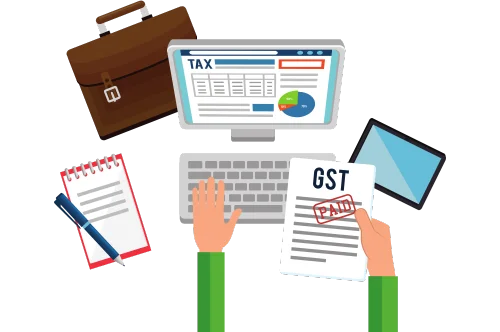Step-by-Step Guide to Filing Revised and Belated ITR
Filing your Income Tax Return (ITR) accurately and within the stipulated timeline is crucial to avoid penalties and scrutiny. However, if you’ve missed the deadline or discovered errors in your original ITR, the Income Tax Department offers you a second chance—through belated returns and revised ITR filing. This blog provides a detailed, step-by-step guide on how to file both revised and belated ITRs, ensuring you remain compliant and stress-free.
What Is a Revised ITR?
A revised ITR allows taxpayers to correct any errors or omissions made while filing the original income tax return. This could include incorrect personal details, inaccurate income disclosure, or missed deductions. The process of revised ITR filing is governed under Section 139(5) of the Income Tax Act, 1961.
What Is a Belated ITR?
A belated ITR is filed when a taxpayer misses the original due date (typically July 31st for individuals not requiring audit). It can be submitted anytime before December 31st of the assessment year (unless extended by the government). Belated returns may attract penalties and interest but ensure the taxpayer meets basic compliance.
Eligibility for Revised ITR Filing
Before you begin, confirm whether you’re eligible for revised ITR filing:
You must have filed your original ITR on or before the due date.
The revision must be made within the time allowed—i.e., before December 31st of the relevant assessment year or before completion of assessment (whichever is earlier).
The revised return can be filed multiple times, as long as it’s within the allowed timeframe.
Step-by-Step Guide to Filing a Revised ITR
Here’s a simple walkthrough for revised ITR filing:
1. Log into the Income Tax Portal
Visit https://www.incometax.gov.in.
Log in using your PAN, password, and captcha.
2. Go to the ‘e-File’ Section
Click on “e-File” > “Income Tax Returns” > “File Income Tax Return”.
Select the assessment year, typically the year following the financial year.
3. Select the Filing Type
Choose “Revised Return” as your filing type.
You will be prompted to enter the acknowledgment number and filing date of your original return.
4. Fill in the Correct Details
Correct any errors or omissions from your original ITR.
Ensure that deductions, income sources, and personal information are accurate.
5. Verify and Submit
After completing the revised ITR filing, you must e-verify it via Aadhaar OTP, bank account, or net banking.
Only verified returns are processed by the department.
Step-by-Step Guide to Filing a Belated ITR
If you missed the original due date, here’s how to file a belated ITR:
1. Login to the Income Tax Portal
Use the same login credentials as mentioned earlier.
2. Choose “Belated Return”
Navigate to “File Income Tax Return” and select “Belated Return” under the filing type.
3. Fill in the Necessary Details
Complete the return with correct income, deduction, and tax paid information.
Make sure to mention that it’s a belated return under Section 139(4).
4. Pay Late Fees and Interest
Belated returns may attract a late fee of up to ₹5,000 under Section 234F, and interest under Sections 234A, 234B, and 234C.
The fee depends on your total income and how late the return is filed.
5. Verify and Submit
As with revised ITR filing, your belated return must be e-verified.
Key Differences Between Revised and Belated ITR Filing
| Feature | Revised ITR Filing | Belated ITR Filing |
|---|---|---|
| Applicable Section | 139(5) | 139(4) |
| Filing Eligibility | Original return filed on time | Missed the original due date |
| Correction Allowed | Yes | No |
| Penalty Applicable | Usually No | Yes (up to ₹5,000) |
| Time Limit | Dec 31 or completion of assessment | Dec 31 of Assessment Year |
Why Revised ITR Filing Matters
Making errors while filing taxes is common. But thanks to revised ITR filing, you have a legal way to fix these mistakes without drawing penalties or prosecution. Here’s why revised ITRs are beneficial:
Avoid Notices: Correcting discrepancies reduces chances of receiving tax department notices.
Claim Missed Deductions: You can include missed deductions and reduce your tax liability.
Fix Mismatched Details: Errors in PAN, income, or bank details can be corrected.
Improve Creditworthiness: Clean tax records help when applying for loans or visas.
Things to Keep in Mind for Revised ITR Filing
Verify Quickly: Always verify your return soon after submission to ensure processing.
Use Correct ITR Form: Choose the right form (ITR-1 to ITR-7) based on your income sources.
Track Your Return: Use the income tax portal to check processing status and refund updates.
Keep Copies: Maintain a copy of both original and revised return for future reference.
Check Form 26AS and AIS: Match TDS and income details before you file the revised return.
Common Mistakes to Avoid
Not quoting the correct acknowledgment number of the original ITR while revising.
Filing a revised ITR after assessment is completed—you can’t revise post-assessment.
Incorrect form selection, which could invalidate the return.
Skipping e-verification, which leaves your return pending.
Final Thoughts
Whether it’s a missed deadline or an honest mistake, taxpayers have ample opportunities to stay compliant through belated and revised ITR filing. However, timing and accuracy are critical. Don’t wait for a notice to rectify errors—be proactive, review your ITR, and file a revised or belated return as necessary.
Make the most of the flexibility the Income Tax Act offers and ensure your financial compliance is on point. Revised ITR filing is not just a correction tool—it’s a second chance to get your taxes right.
Our GST Services

All E-commerce Tax services
E-commerce tax services help online sellers navigate GST registration, compliance, return filing, TCS management, tax planning, and audits, ensuring efficient tax management and legal compliance.

GST Filing
GST filing is the process of submitting tax returns to the government, detailing sales, purchases, and taxes paid or collected, ensuring compliance with GST laws.

GST Registration
GST registration is the process where businesses obtain a GSTIN from the government, allowing them to collect taxes, claim input tax credits, and comply with GST laws.





